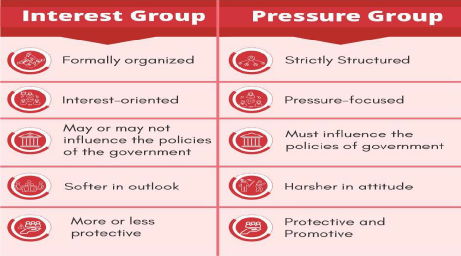i. Interest Groups and Cause Groups
ii. Insider and outsider groups
i. Interest and Cause Groups
The interest/cause classification is based on the purpose of the group in question. It therefore reflects the nature of the group’s goals, the kind of people who belong to it, and their motivation for joining.
Interest groups (sometimes called ‘sectional’, ‘protective’ or ‘functional’ groups) are groups that represent a particular section of society: workers, employers, consumers, an ethnic or religious group, and so on.
Interest groups have the following features:
♤ They are concerned to protect or advance the interests of their members.
♤ Membership is limited to people in a particular occupation, career or economic position.
♤ Members are motivated by material self-interest.
Trade unions, business corporations, trade associations and professional bodies are the prime examples of this type of group. They are called ‘sectional’ groups because they represent a particular section of the population. Some of the examples of interest groups are FICCI, CII, AITUC etc.
While sometimes, the terms interest groups and pressure groups are used interchangeably, there are following differences between the two:


Interest groups can be classified into four categories-
i) Institutional Interest Groups: These groups are formally organised which consist of professionally employed persons. They are a part of government machinery and try to exert their influence. But they do have much autonomy. These groups include political parties, legislatures, armies, bureaucracies, churches etc. An example of institutional group can be the West Bengal Civil Services Association. Whenever such an association raises protest it does so by constitutional means and in accordance with the rules and regulations.
ii) Associational Interest Groups: These are organised specialised groups formed for interest articulation, but to pursue limited goals. These include trade unions, organisations of businessmen and industrialists and civic groups. Some examples of Associational Interest Groups in India are Bengal Chamber of Commerce and Industry, Indian Chambers of Commerce, Trade Unions such as AITUC (All India Trade Union Congress), Teachers Associations, Students Associations such as National Students Union of India (NSUI) etc.
iii) Anomic Interest Groups: These are the groups that have analogy with individual self- representation. In such type of groups, perpetual infiltrations such as riots, demonstrations are observed. These groups are found in the shape of movement demonstrations and processions, signature campaigns, street corner meetings, etc. Their activities may either be constitutional or unconstitutional.
iv) Non-Associational Interest Groups: These are the kinship and lineage groups and ethnic, regional, status and class groups that articulate interests on the basis of individuals, family and religious heads. These groups have informal structure. These include caste groups, language groups, etc.
Cause groups (sometimes called ‘promotional’, ‘attitude’ or ‘issue’ groups) are groups that are based on shared attitudes or values, rather than the common interests of its members. The causes they seek to advance are many and various. They range from charity activities, poverty reduction, education and the environment, to human rights, transparency in governance etc.
Cause groups have the following features:
♤ They seek to advance particular ideals or principles.
♤ Membership is open to all.
♤ Members are motivated by moral or altruistic concerns (the betterment of others).
Mazdoor Kisan Shakti Sangathan (MKSS) can be cited as a prime example of a cause group as it seeks to promote transparency in governance, for example, by creating pressure for the introduction of right to information to citizens. Other examples could be PETA, India against Corruption etc.

